Pozdrav,
neznam da li ima vec tema o ovome, ako nema, covjek tjunira Yamahu aerox uz dynometar, znaci sve se vidi kakav je koji spuh, kakv je koji kit, kako rolice utjecu na ponasanje skutera, jako zanimljivo, jer se vide rezultati na papiru odmah. Svako ko razumije osnovni engleski ce se snac!
Ako modovi dozvole, ovo bi bio super sticky, jer stvarno ima puno odgovora kaj ljude muci na njihovim skuterima!
Ja sam izvukao dijagrame za one kojima se neda citata, tko zeli vise, neka pogleda na linkove o cemu se radi, ima puno informacija za onoga koga zanimaju takve stvari preporucio bih im da procitaju sve u linkovima!!
1. Utjecaj mase rolica:
http://www.pedparts.co.uk/blog/moped-tuning--rollers
2. cilindri sa LeoVince ZX
http://www.pedparts.co.uk/blog/moped-tuning-with-a-dyno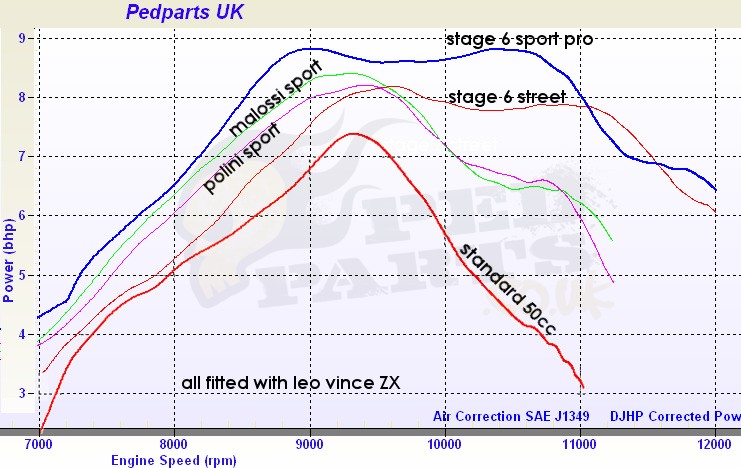
3. usporedba fergazera
This is a blog to show how restrictive the standard 12mm carb is as fitted to a mildly tuned Yamaha Aerox 50cc moped, and subsequently explain why standard Aerox's sometimes struggle to pull away after a powerpipe has been fitted
The following dyno graph is for Yamaha Aerox which was standard apart from a PM Tuning 360 exhaust, Polini 70cc sport cylinder big bore kit, and gear up kit.
http://www.pedparts.co.uk/blog/yamaha-aerox-carb-comparison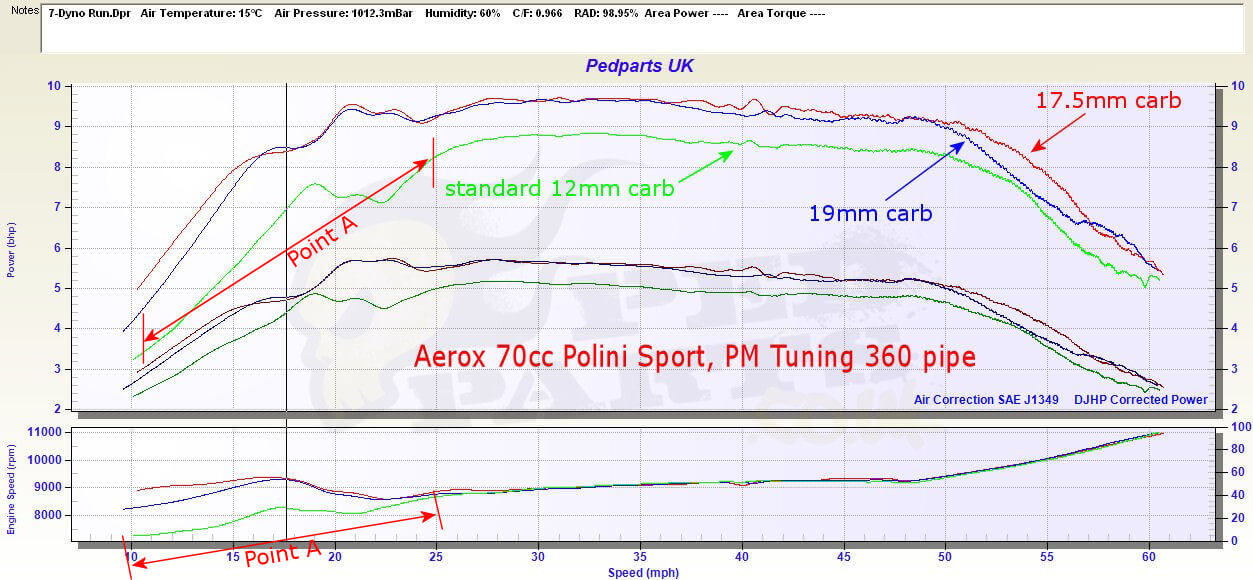
We can see this starting to happen if we look at the graph above at point A. You can see that the green graph for the standard carb is consistently almost exactly 1hp lower than the 17.5 and 19mm carbs at all speeds *except* below 25mph. Below 25mph the power is very significantly down on the standard carb, at 10mph the 17.5mm carb is allowing the engine to develop a massive 70% increase in power of the standard carb which is completely out of proportion with the 1hp (approx 12%) increase seen at higher speeds but why is this ?
The answer is that it's mostly due to the fact that the original Aerox moped variator is particularly poor when used with anything other than a bog standard Aerox.
Usporedba auspuha:
If we look at this graph here which is for a 50cc standard cylinder...
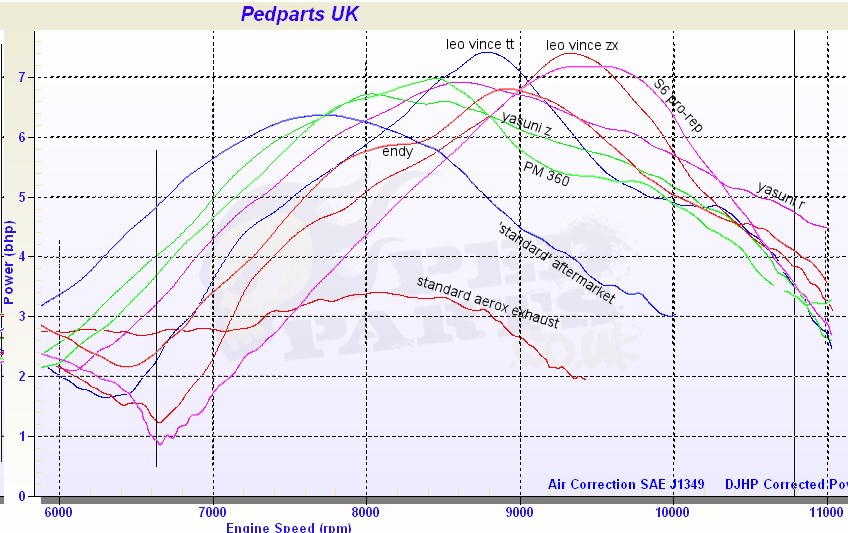
and look at the graph for the standard Aerox exhaust you'll see that at anything below 6800rpm the standard exhaust makes more power than a Leo Vince ZX, TT, and Stage6 Pro rep, or indeed any other half decent sports powerpipe which has a high (but narrow) powerband.
Although ideally the variator would allow the engine to rev straight to peak power whenever you throttle, the standard aerox variator tends to always engage progressively meaning that it requires a fair amount of power to initially get it there. On the high performing pipes, especially in combination with a worn standard Aerox variator this progressive application means that due to the pipe developing lower power than a standard pipe at low revs it sometimes simply can't pull through to get to the higher revs
Oy Mate, what's the best exhaust?
We get asked this everyday, so this afternoon we ran up some different scooter exhausts to compare.
The bike used was a completely standard 50cc Yamaha Aerox. It's important to note that these results are only relevant to standard 50cc. If the bike was further modified e.g. different cylinder kit etc. pipes that appear poor in this test could come into their own and vice versa.
We'll repeat the test at some point with different cylinder kits fitted.
Feel free to skip down to the results if you're not interested in the technicals !
The Technicals...
The pipes chosen for the test are popular budget pipes, more expensive exhaust pipes are designed to work with more highly tuned bikes and tend to work poorly with standard 50cc kits. For example the PM Tuning 360 and Yasuni R exhaust pipes don't perform brilliantly in this test because they're designed to work with much higher revving cylinder kits.
The first graph contains all the pipes tested for direct comparison. For the tests we've removed the variator and used fixed gearing to get a proper power curve for each exhaust so you can see exactly what power the pipe makes at different rpms.
The pipe which made the most peak power was the Leo Vince ZX and (suprisingly) the Leo Vince TT with the Stage 6 Pro Rep very close behind.

Of course things are never this simple and the pipe that develops the highest peak power isn't necessarily the pipe which makes the fastest bike.
Take the Leo Vince TT for example. You can see from the graph that it makes a very respectable 7.5hp at 8,800rpm. This means that if you play with the roller weights until the bike runs at 8,800rpm (a good variator will hold it there steadily) you'll have 7.5hp available whenever you mash the throttle and at whatever speed you're going. None of the other pipes can better this...
However once you reach a certain speed (approx 30mph on a standard bike) the variator has moved all the way out and will no longer be able to hold the revs at 8,800. This means that the only way the bike can now go faster is for the revs to increase.
You'll notice on the budget pipes (e.g. the TT and the Endy pipe that the power they produce drops off very quickly at higher revs.
If we look for example at 9500rpms we can see that the power for the TT and Endy pipe has dropped off to around 6hp already whilst the Leo Vince ZX and Stage 6 Pro Rep are producing over 7hp at this rpm. Because this rpm would represent a road speed of approx 35-38mph this extra 1hp can make the bike substantially quicker. 1hp might not make a huge difference when accelerating from 10mph to 15mph but accelerating from 35 to 40mph this difference is definitely noticeable and because of this the higher revving pipes are significantly quicker in the real world when fitted to an otherwise standard engine. These also tend to be the pipes that work well if you later upgrade to a 70cc kit which is normally designed to run at slightly higher revs than standard.
It's worth noting though that the lower revving pipes can be easier to setup. Take the Yasuni Z for example, it makes more than 5hp all the way from 7000rpm to almost 10,200rpm, a range of over 3000rpm. The Leo Vince makes over 5hp only over a range of 2000rpm. This means that the Yasuni Z, although being a lower performing pipe will be very tolerant and easy to set it up.
Even if you get the rollers wrong and the variator is worn (can't hold the revs constant) it will still perform well as it's powerband is so wide.
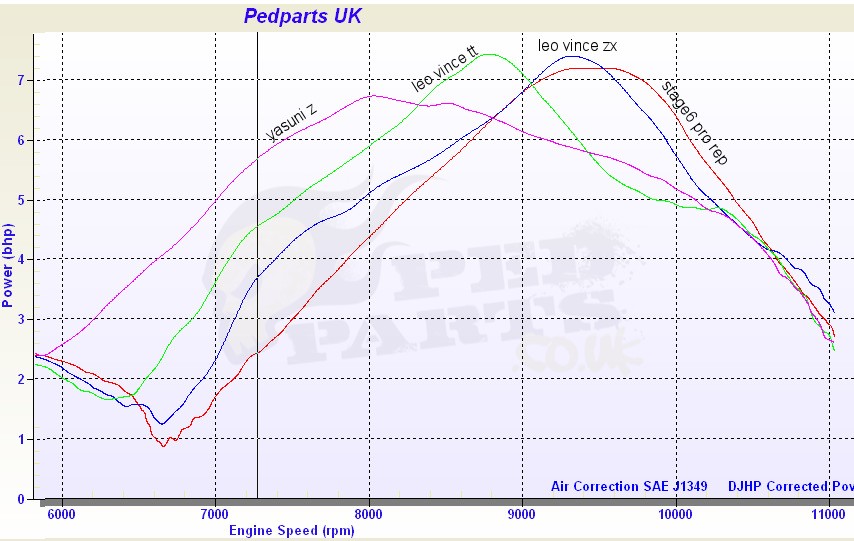 REZULTATE pogledajte na:http://www.pedparts.co.uk/blog/stage-6-pro-replica-exhaust-triumphs-exhaust-shootout
REZULTATE pogledajte na:http://www.pedparts.co.uk/blog/stage-6-pro-replica-exhaust-triumphs-exhaust-shootout4. Opcenito o Dyno tuningu
http://www.pedparts.co.uk/blog/moped-tuning5. sve o podesavanju smjese, diznama i kako utjecu svi parametri
http://www.pedparts.co.uk/blog/introduction-to-moped-jetting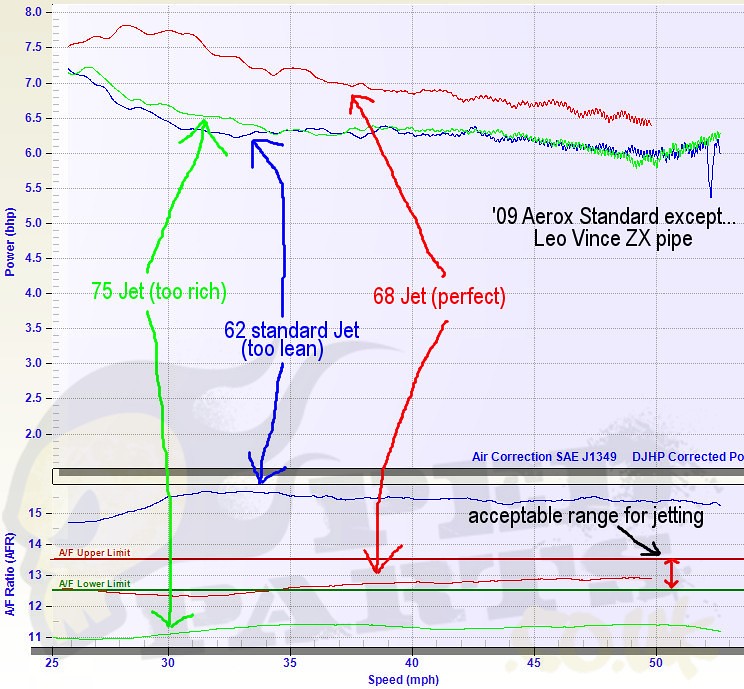
EDIT:
malo sam copy pasto neke stvari, ali ljudi, nebudite lijeni, procitajte i bit ce vam sve jasno, neda mi se cijeli tekst copy pastat!